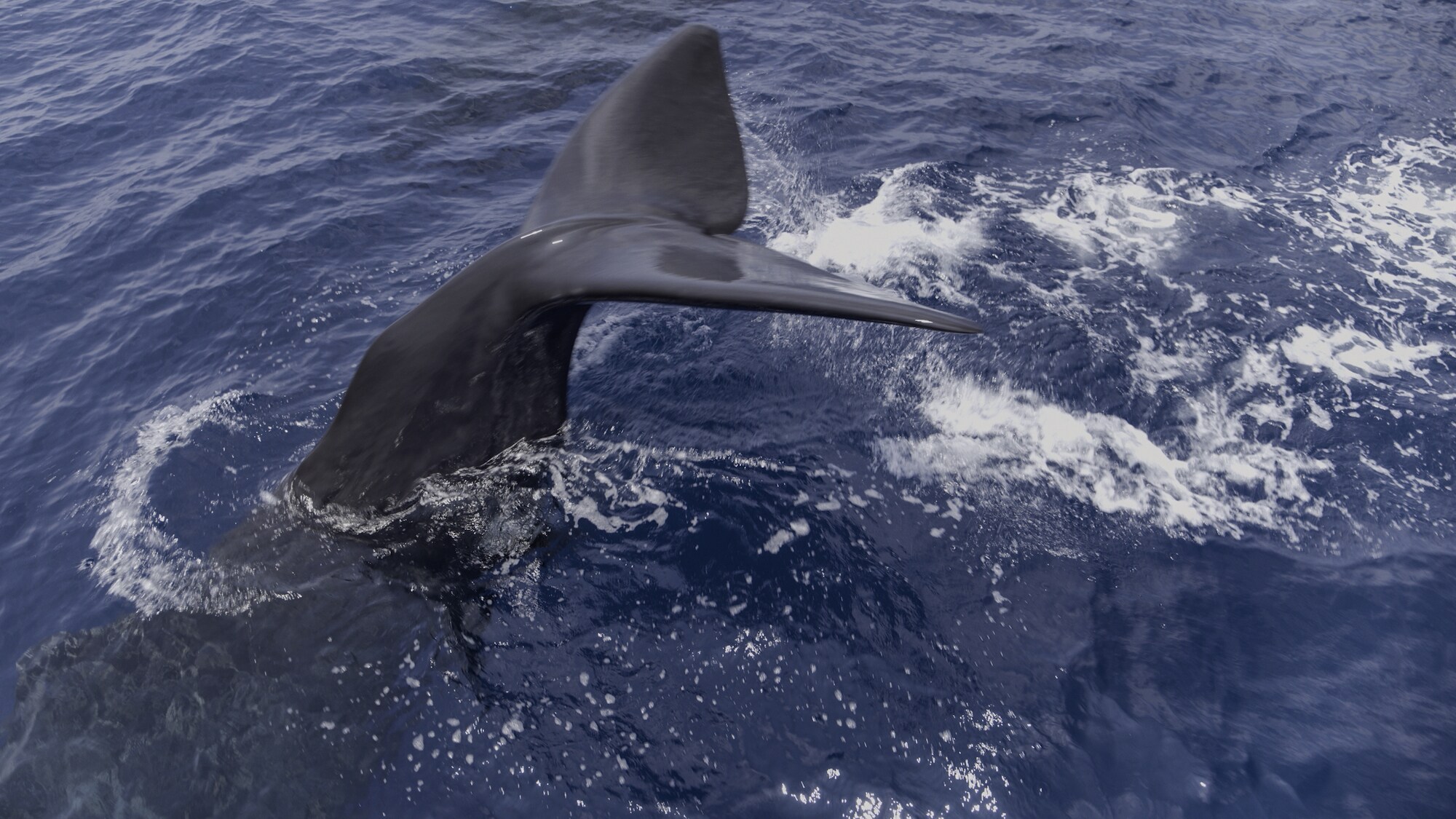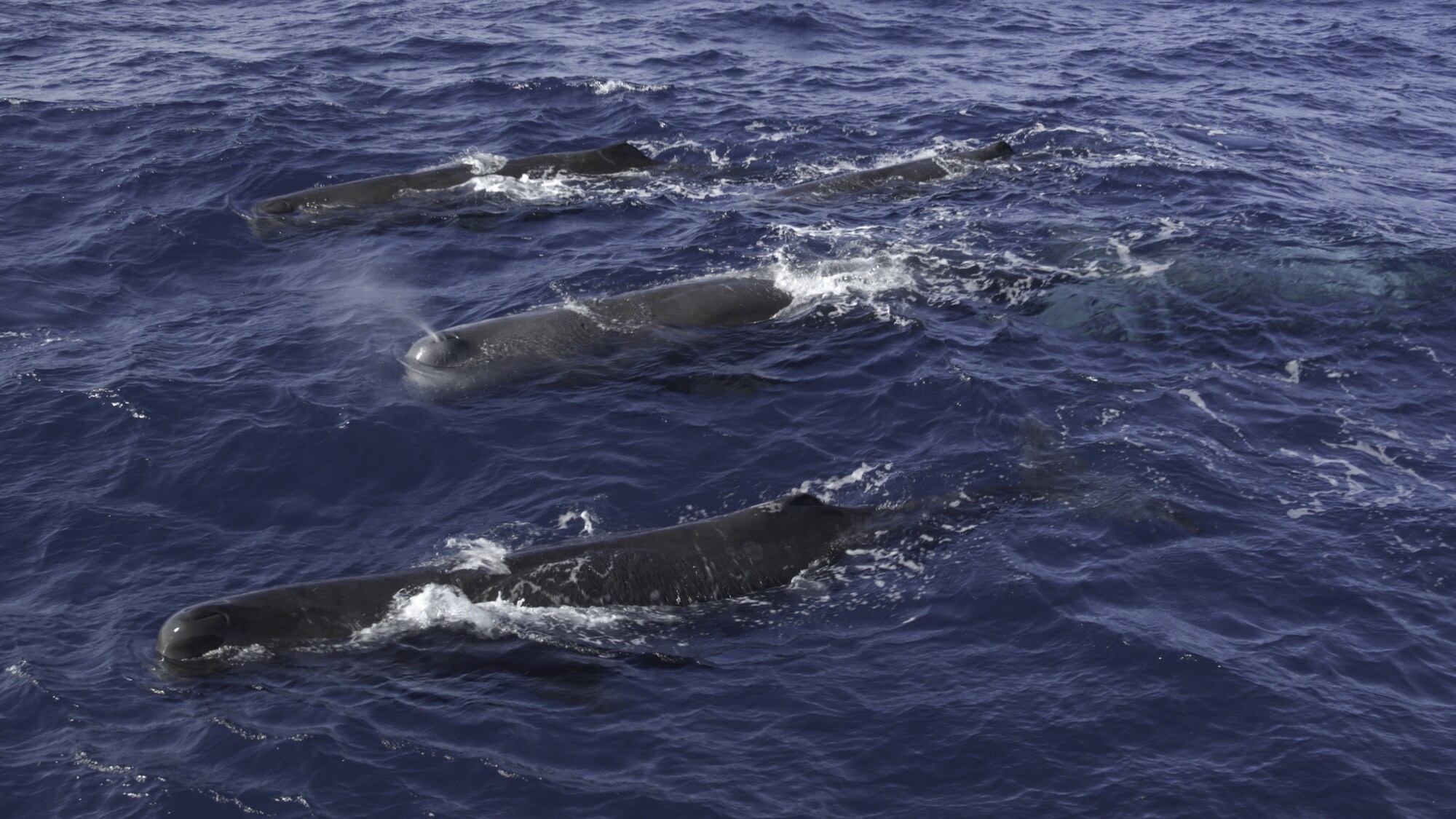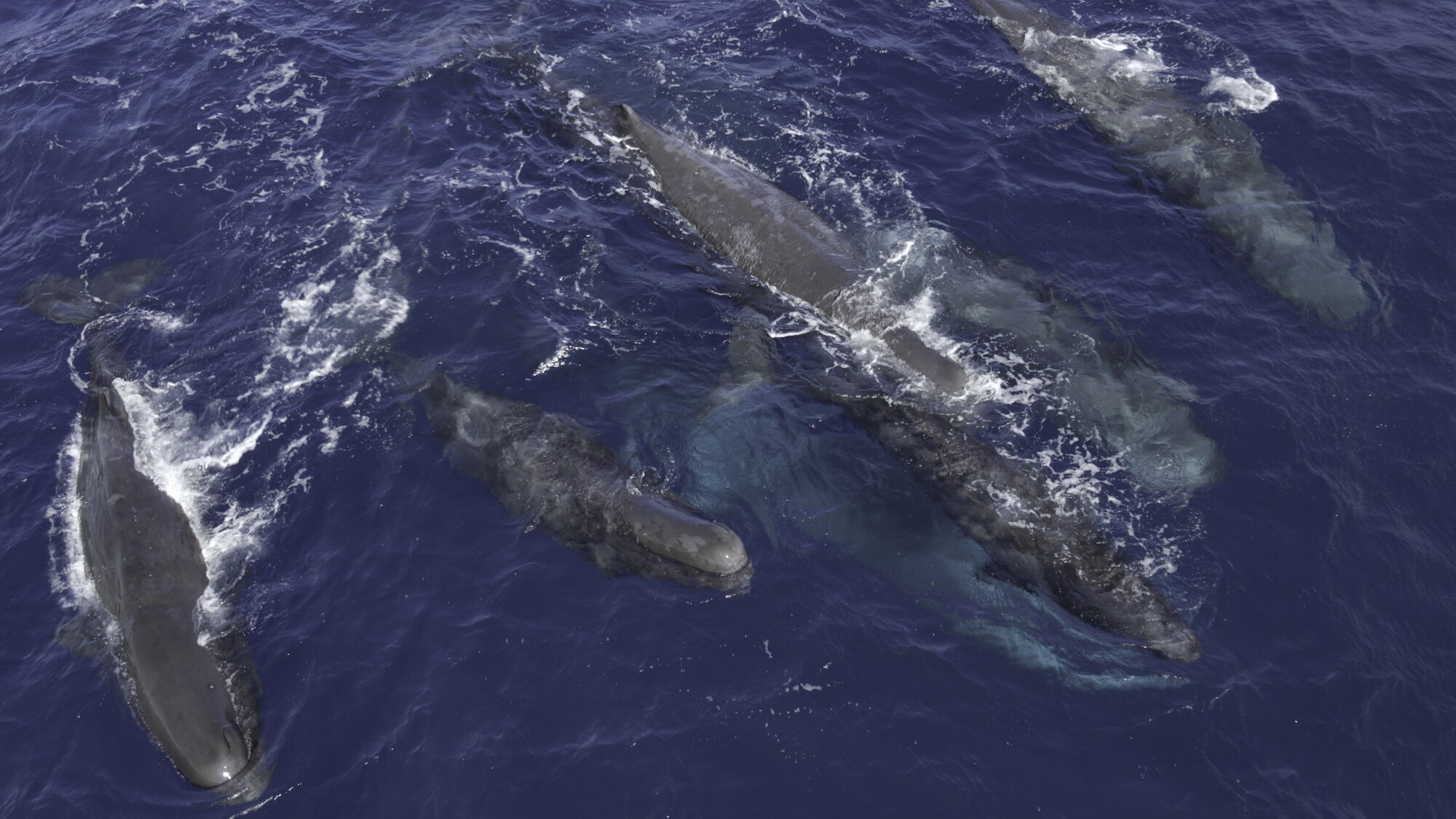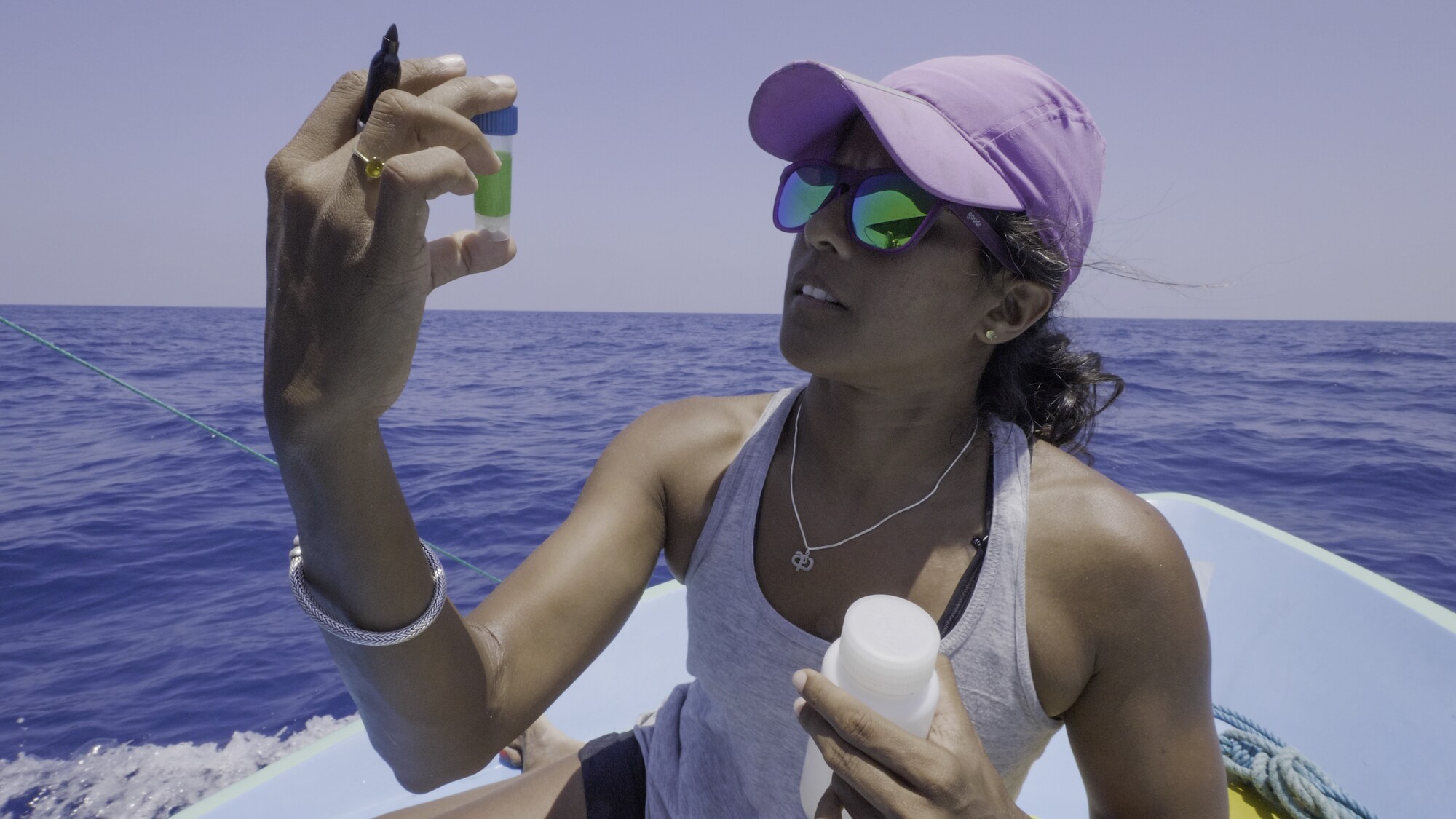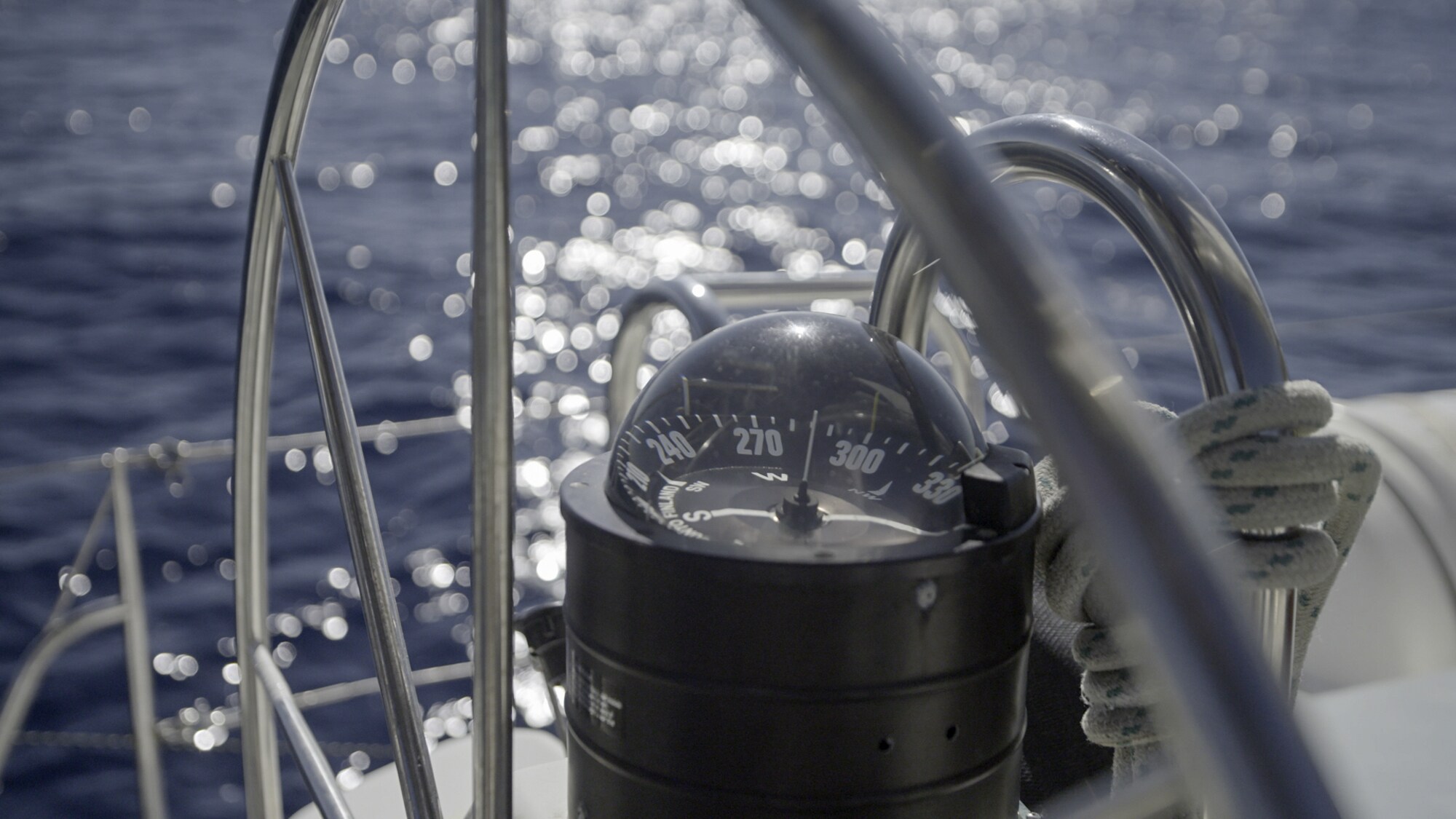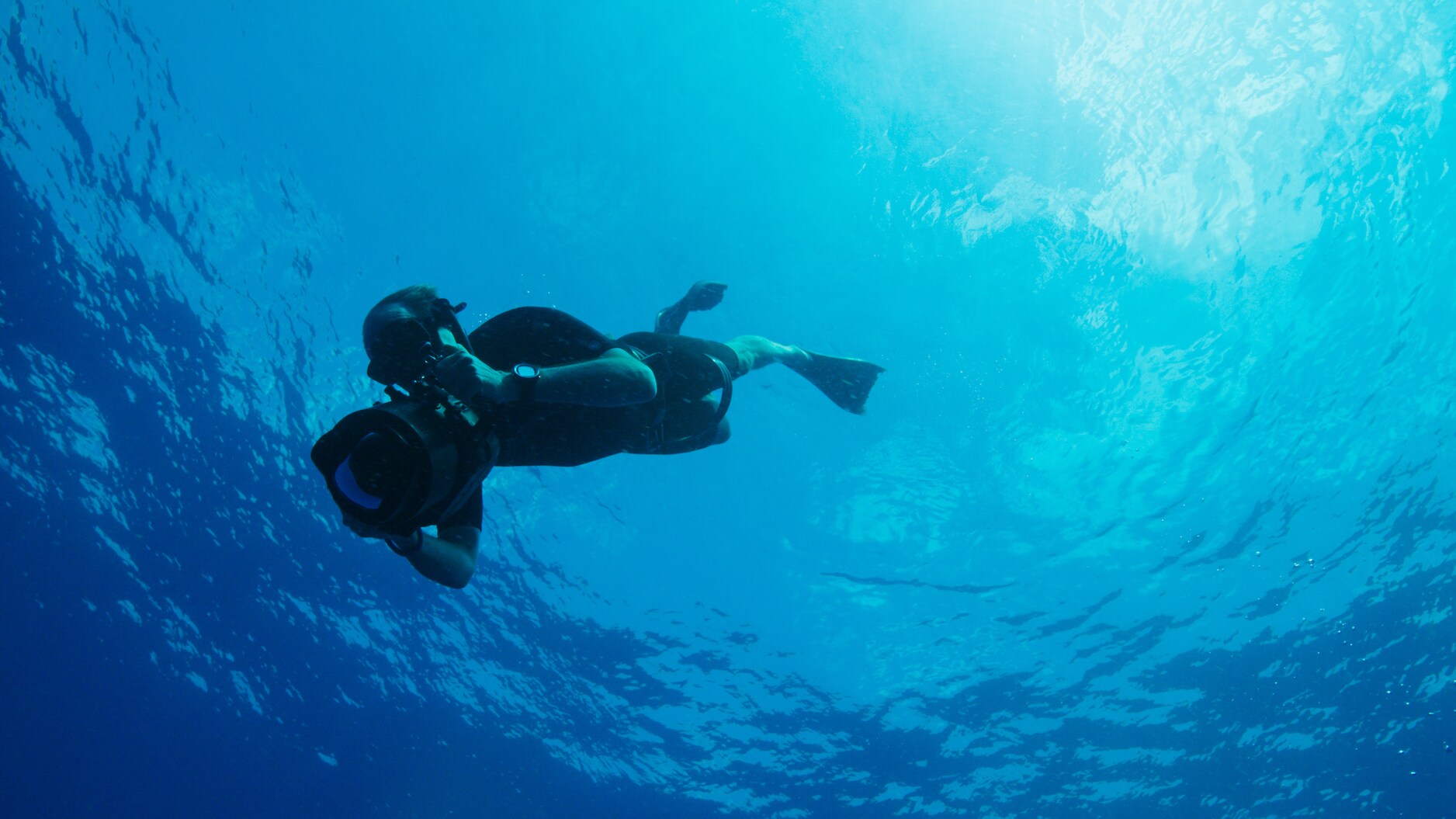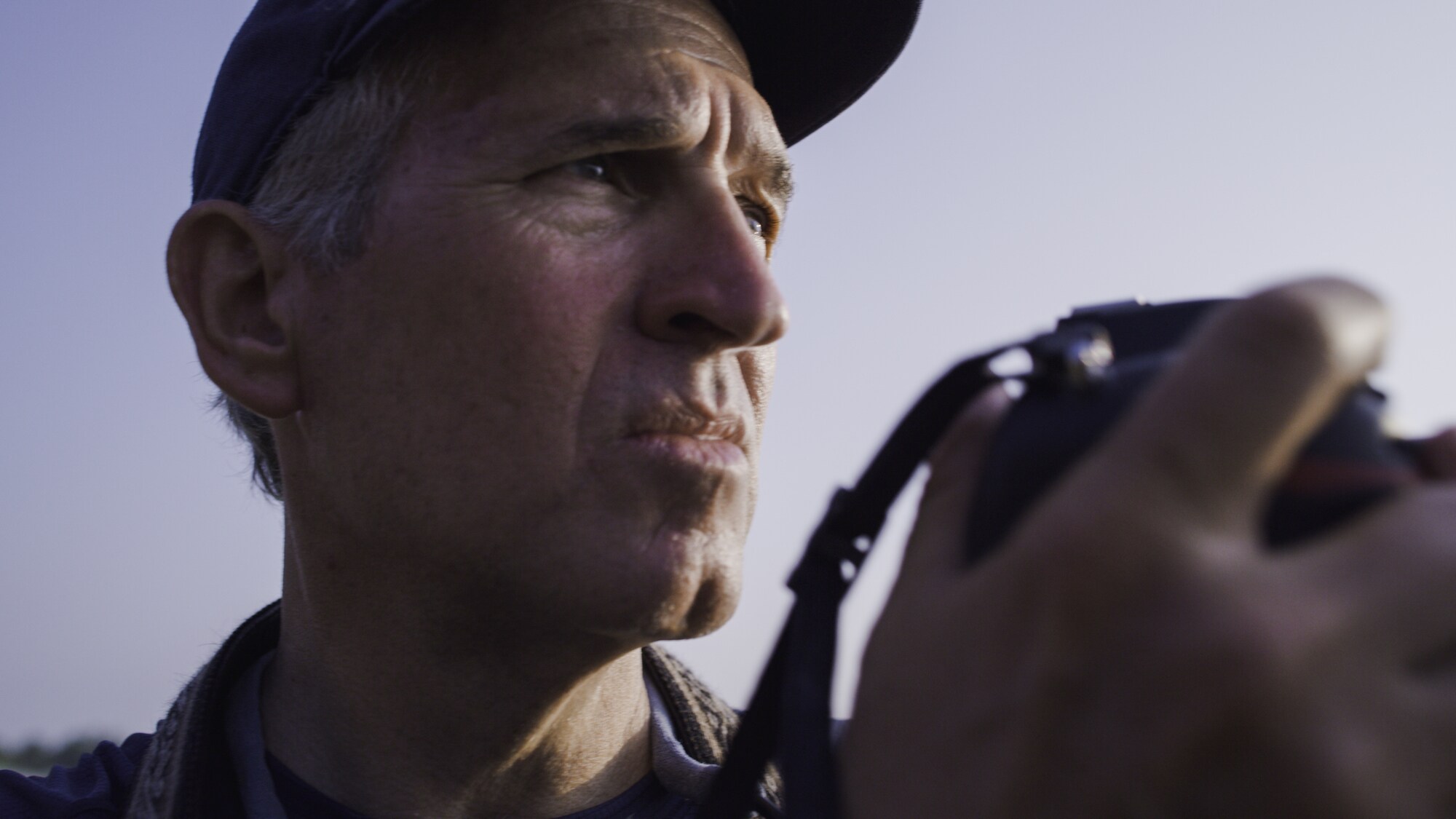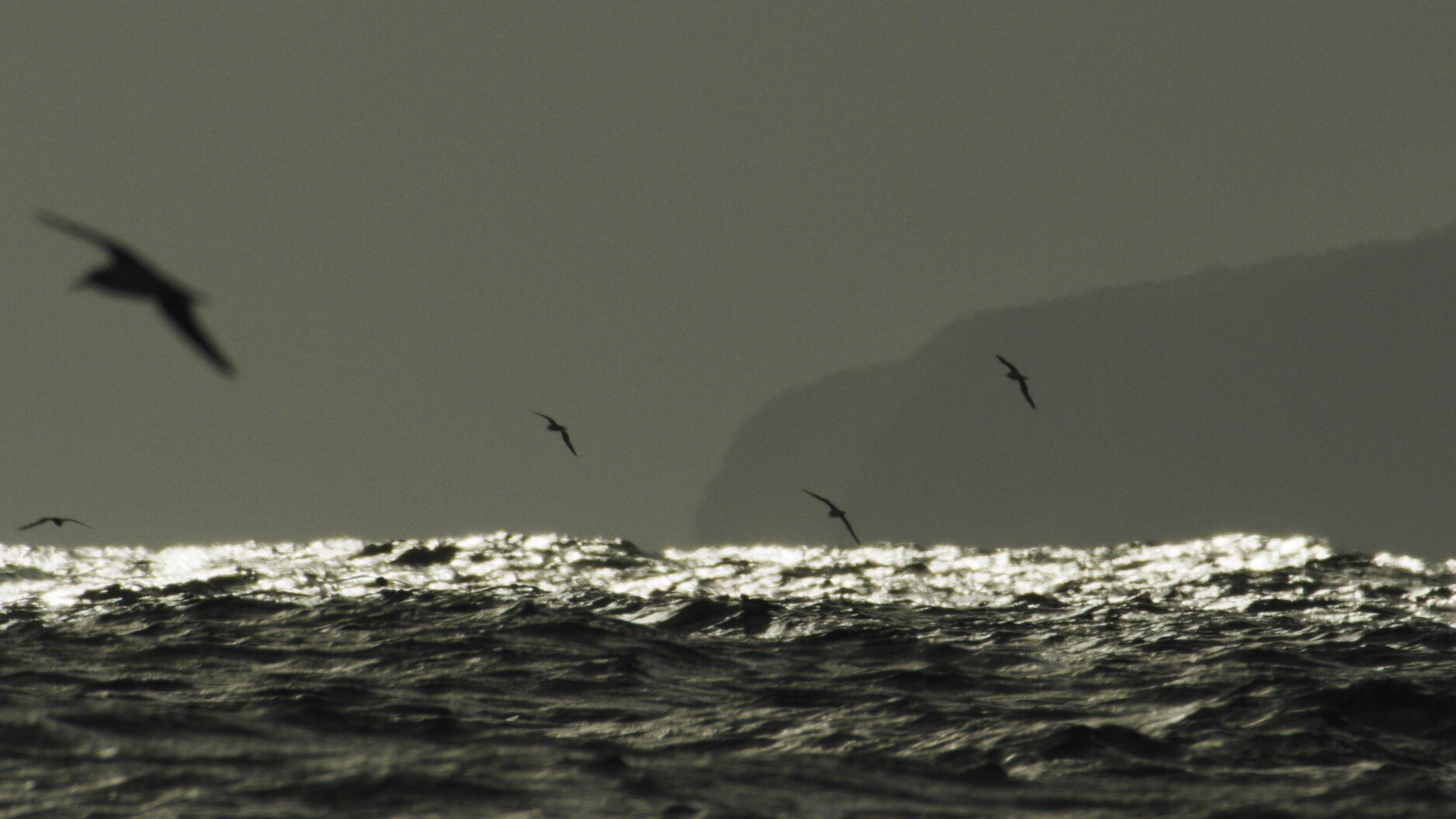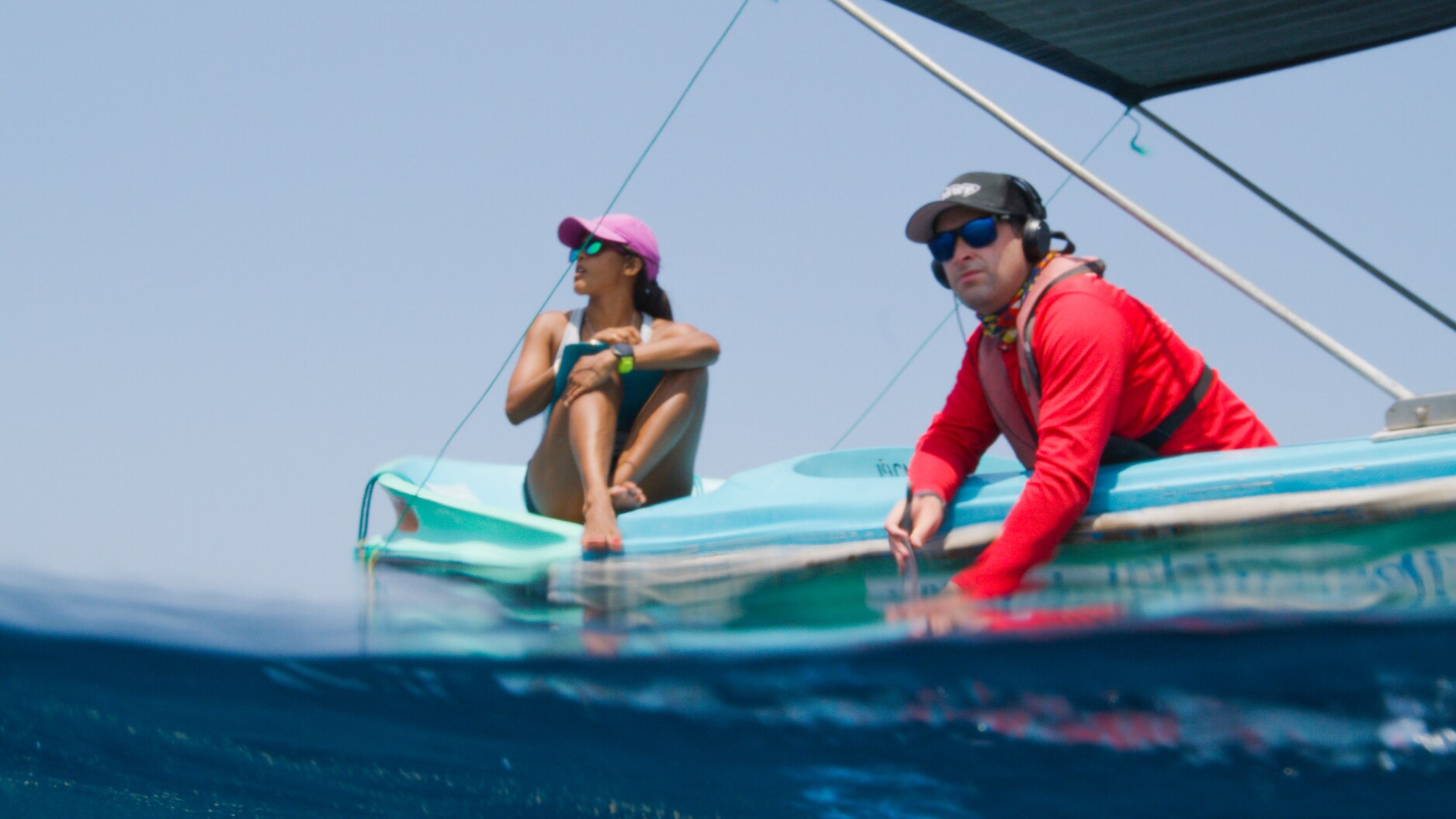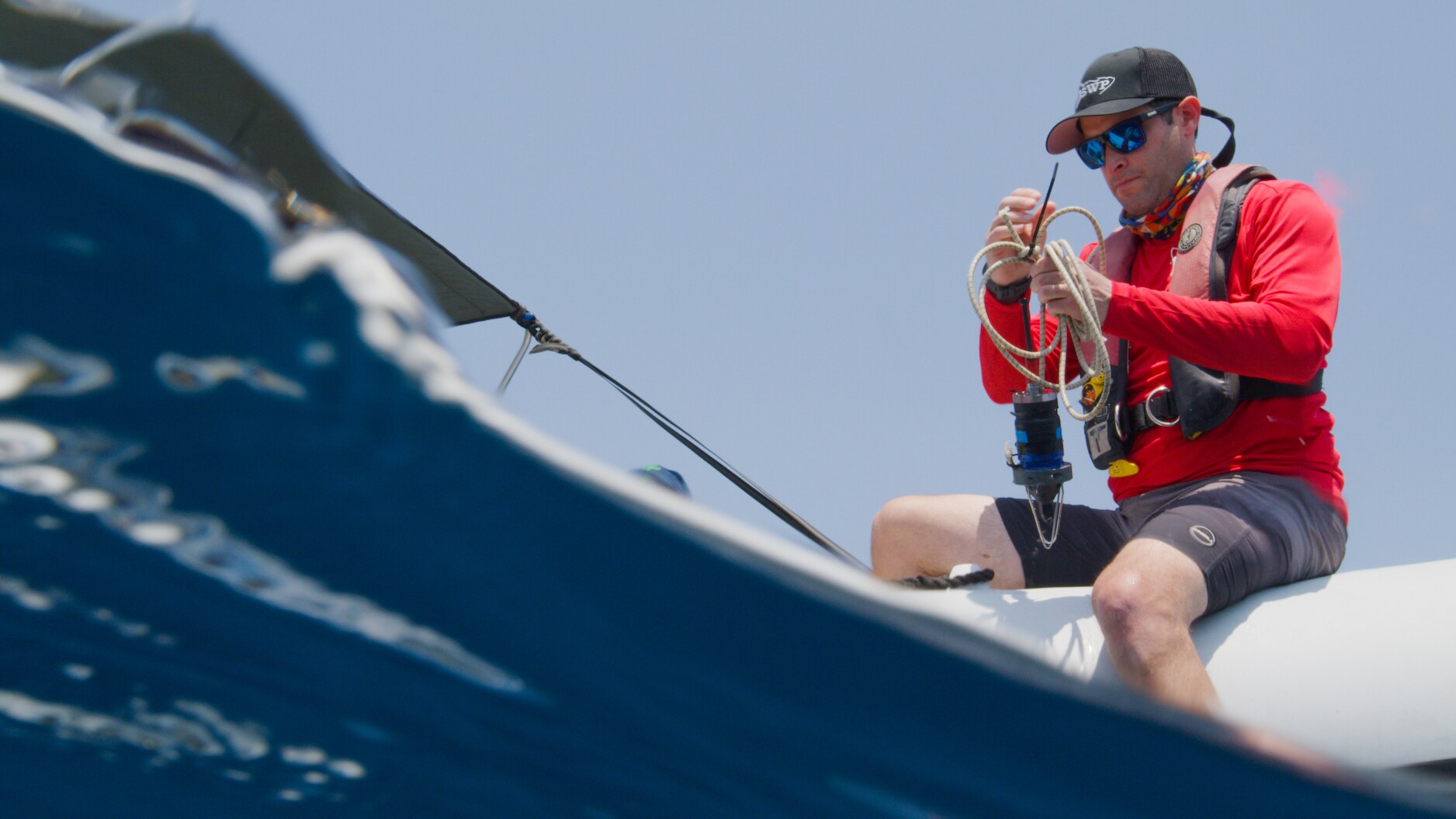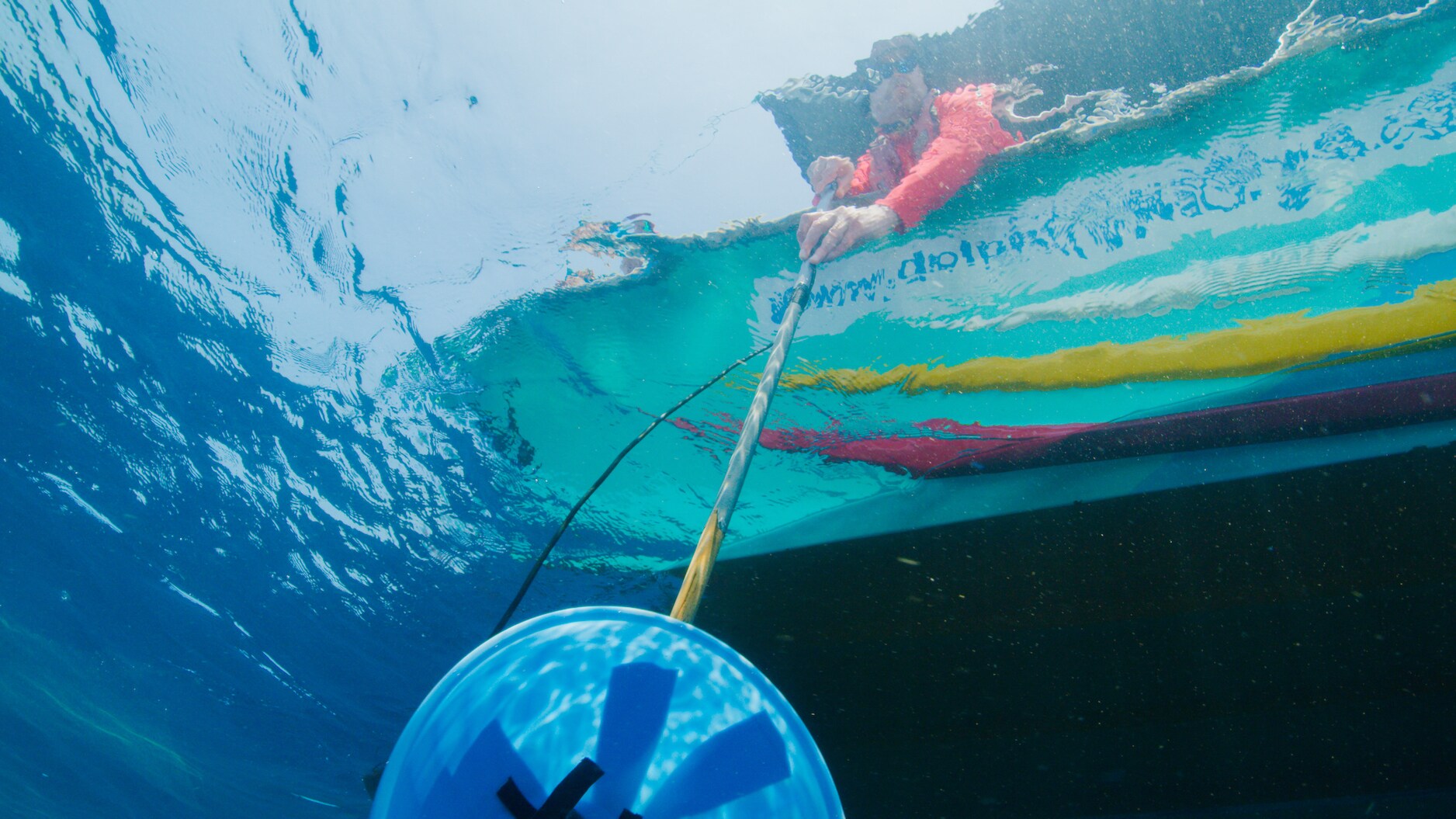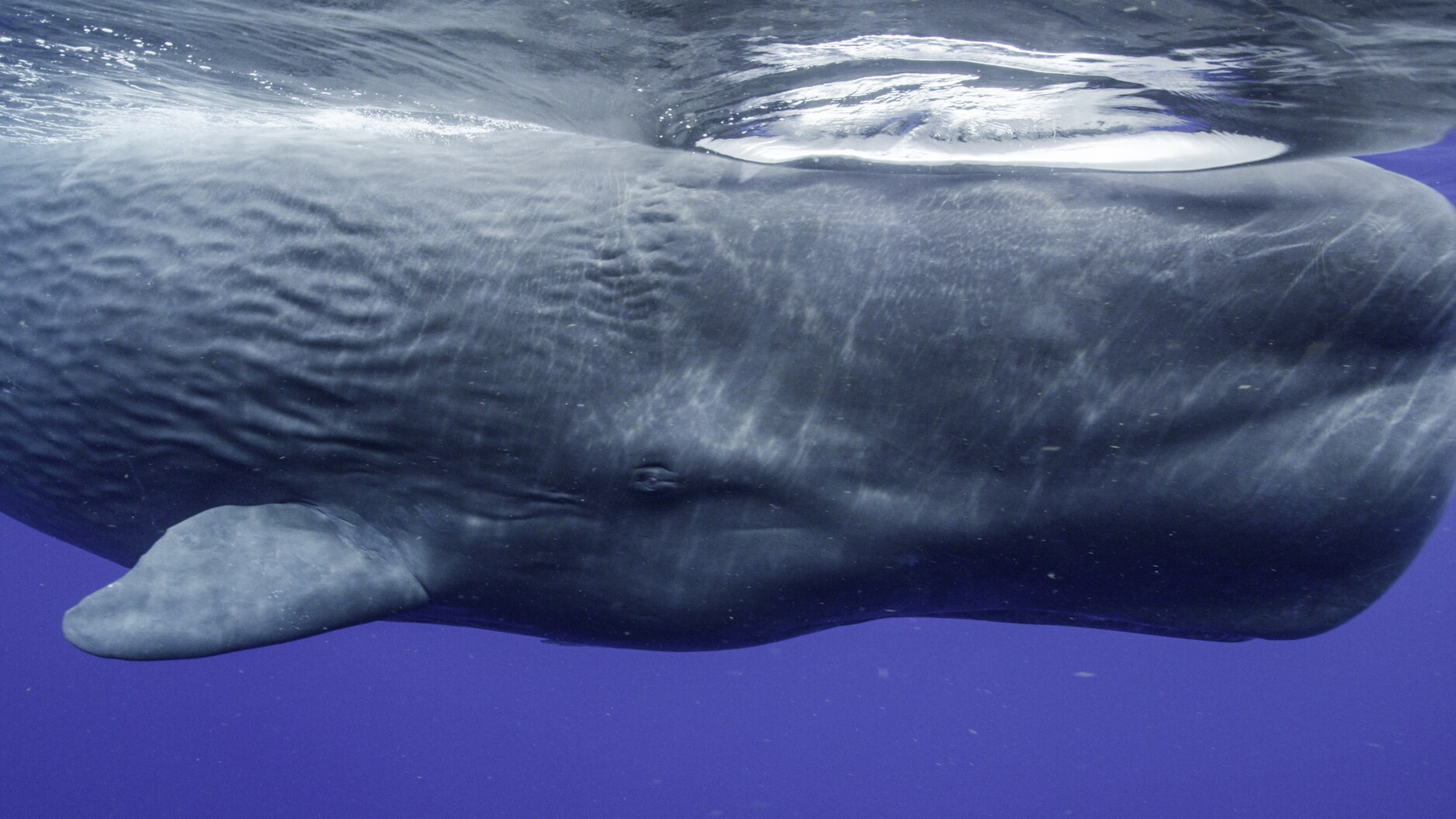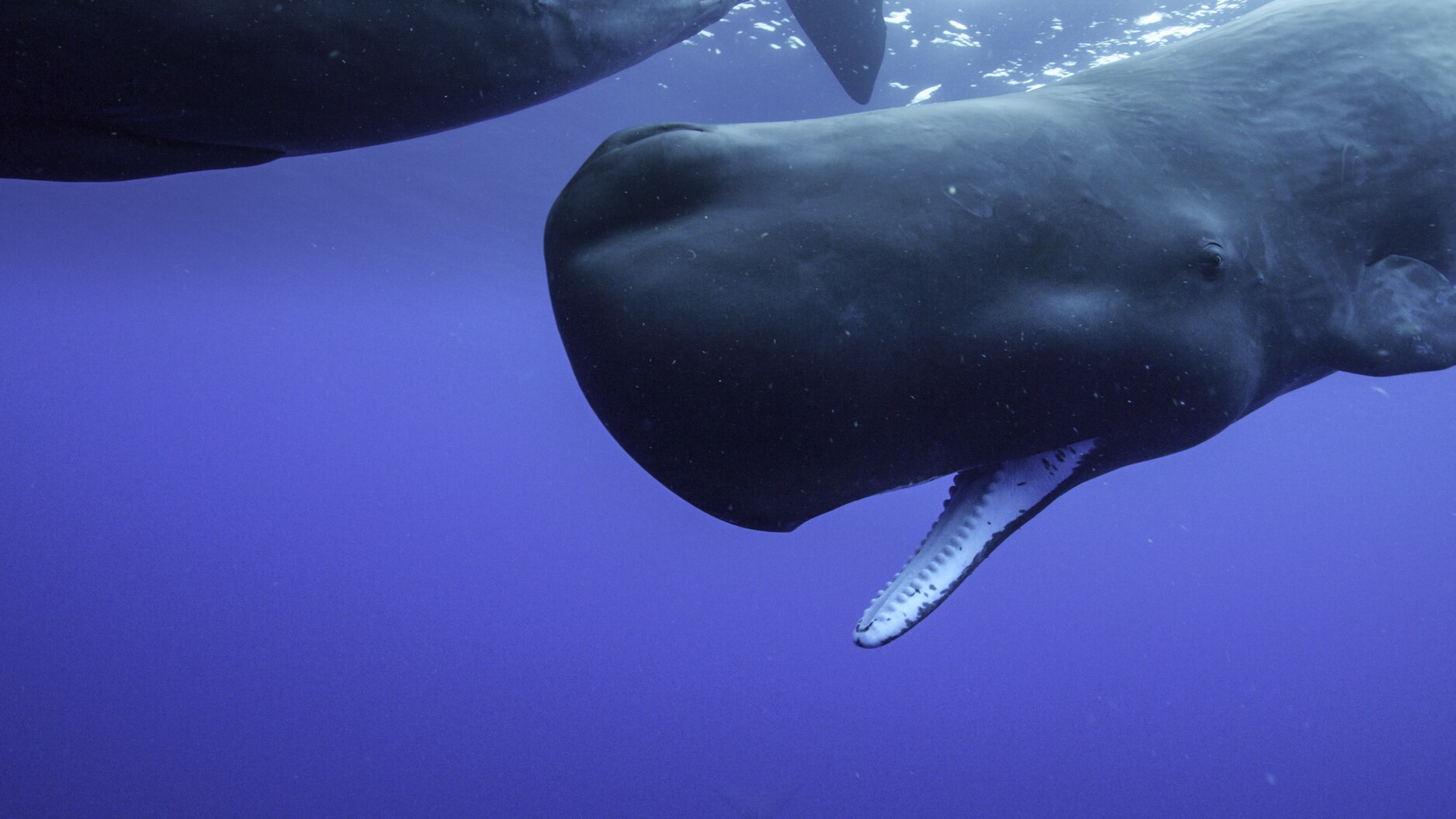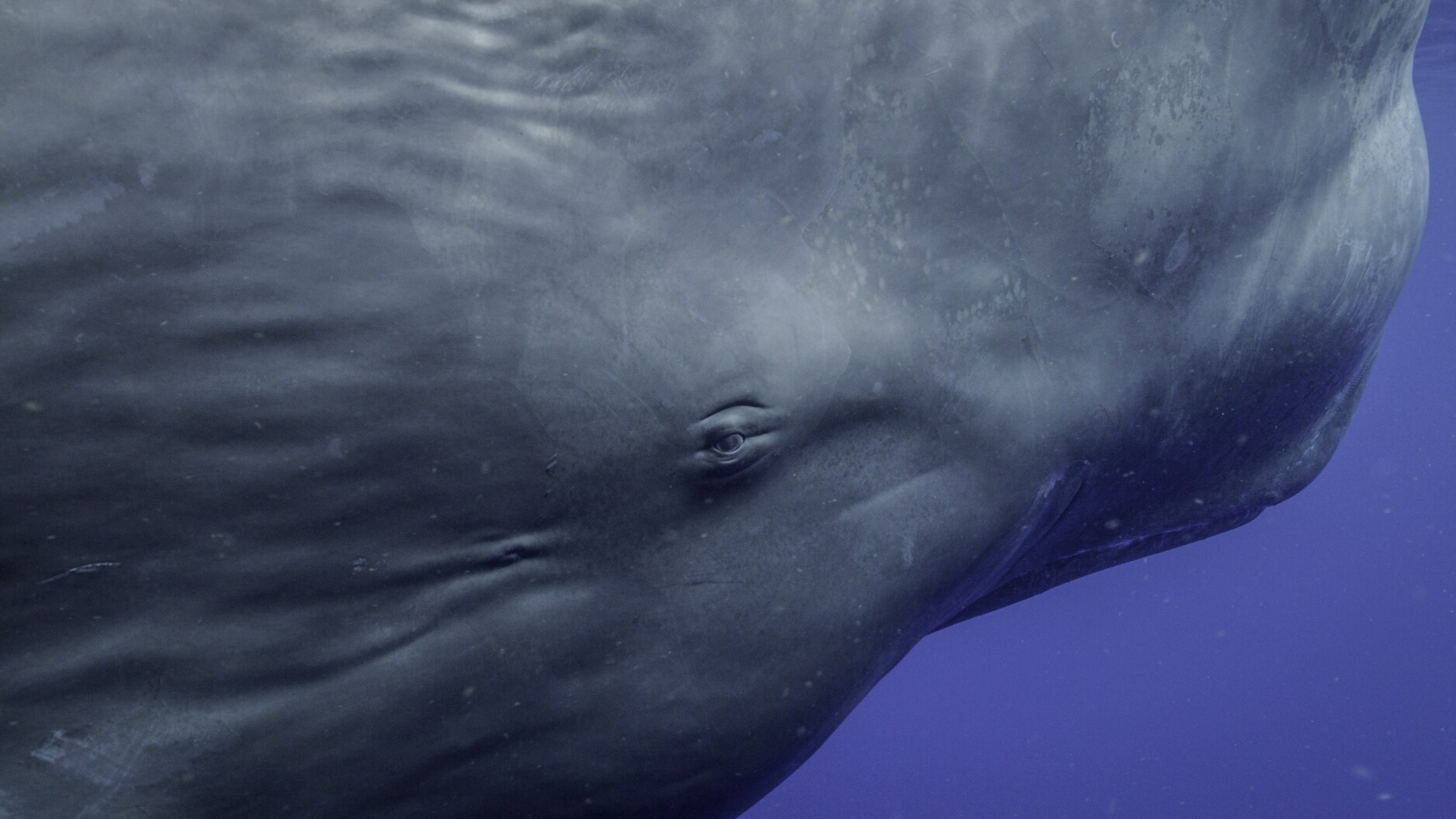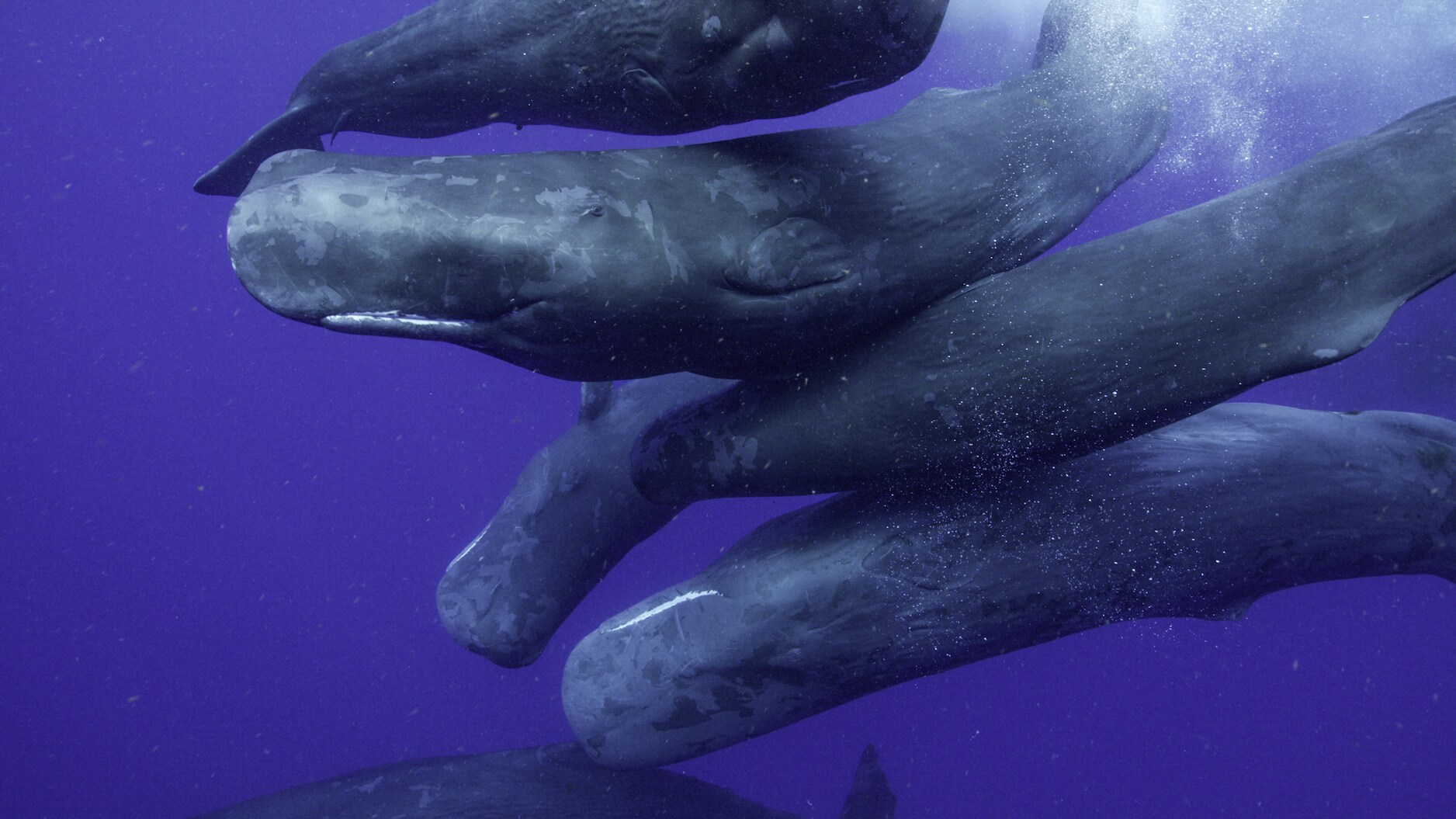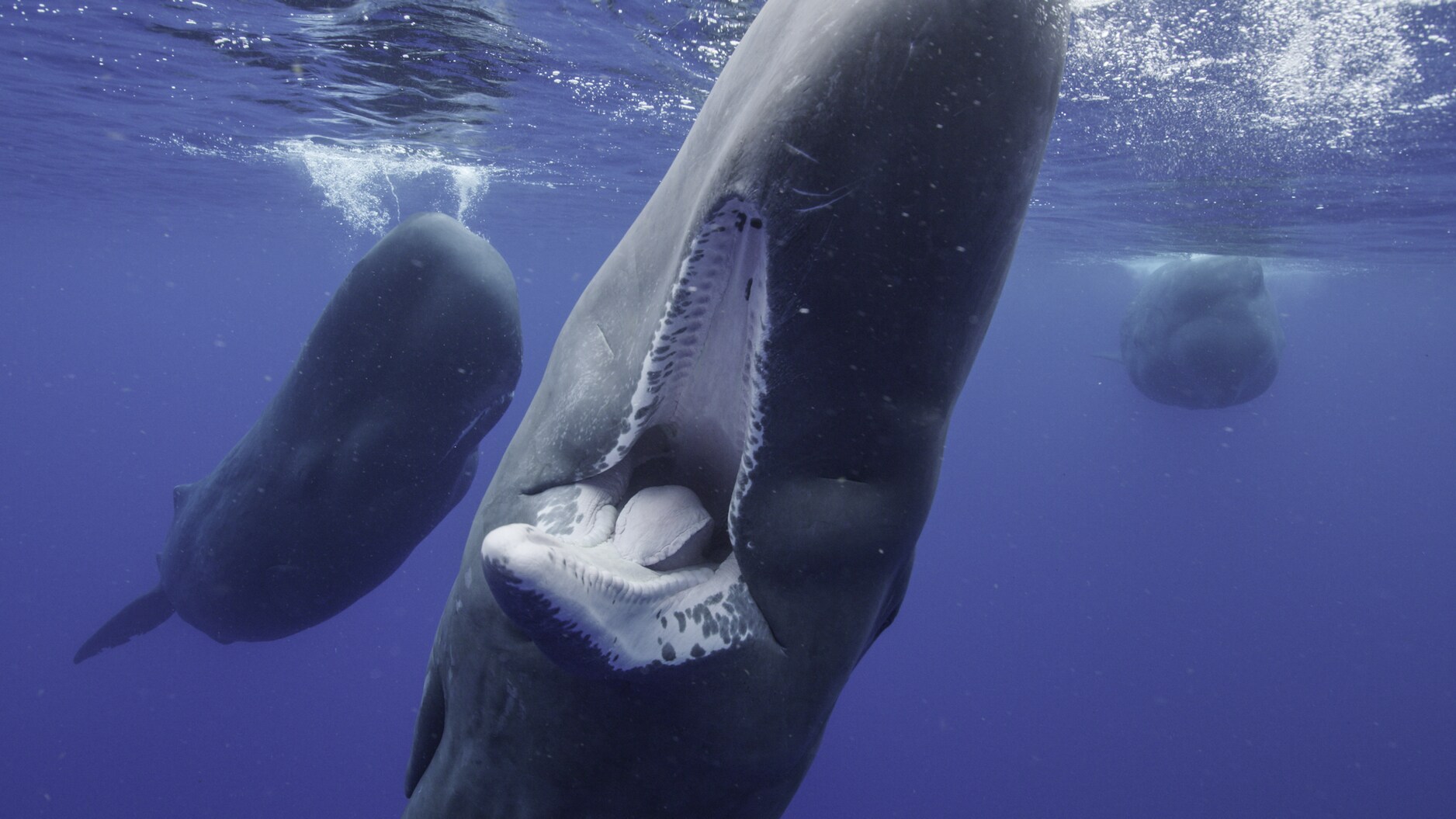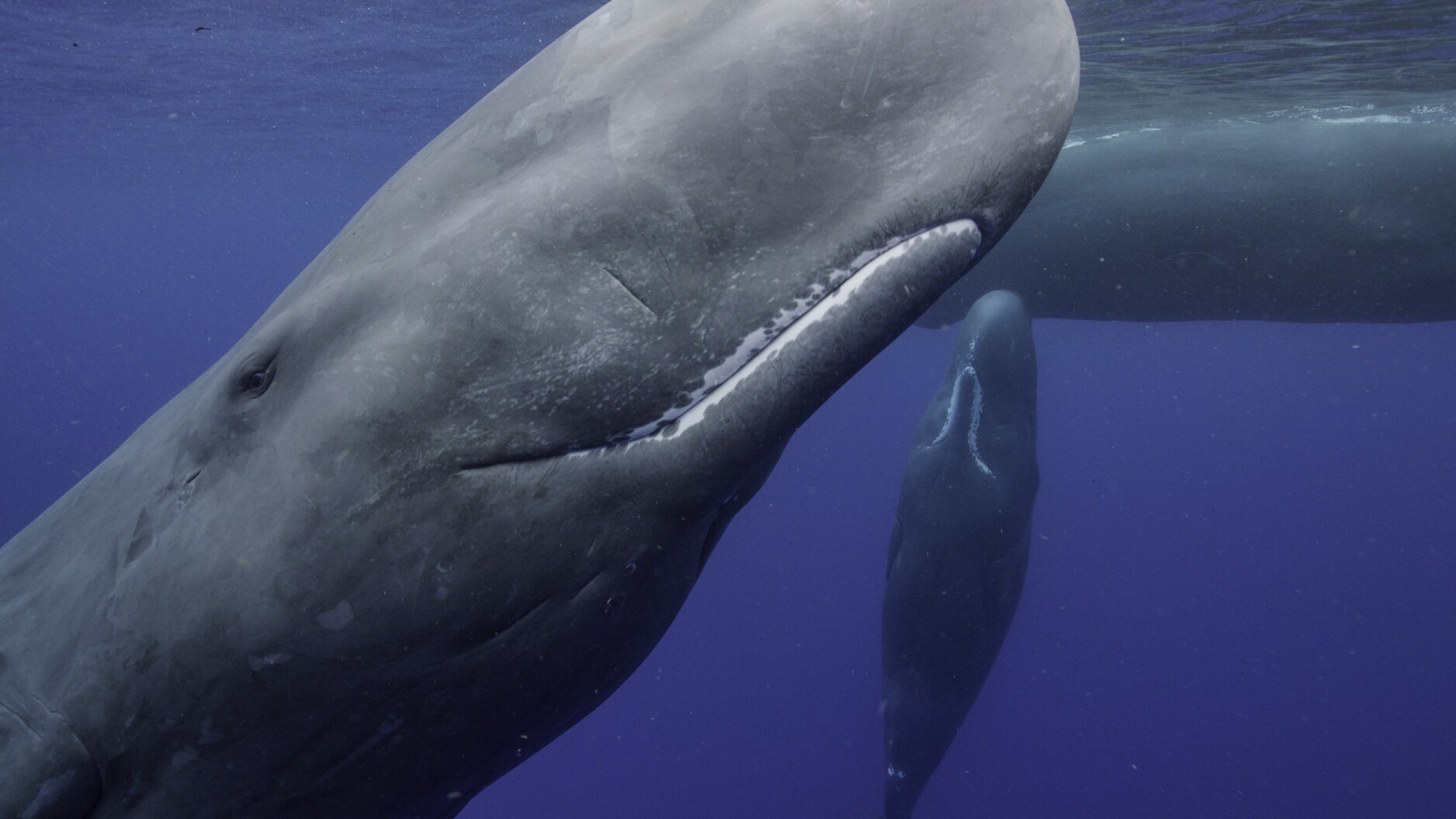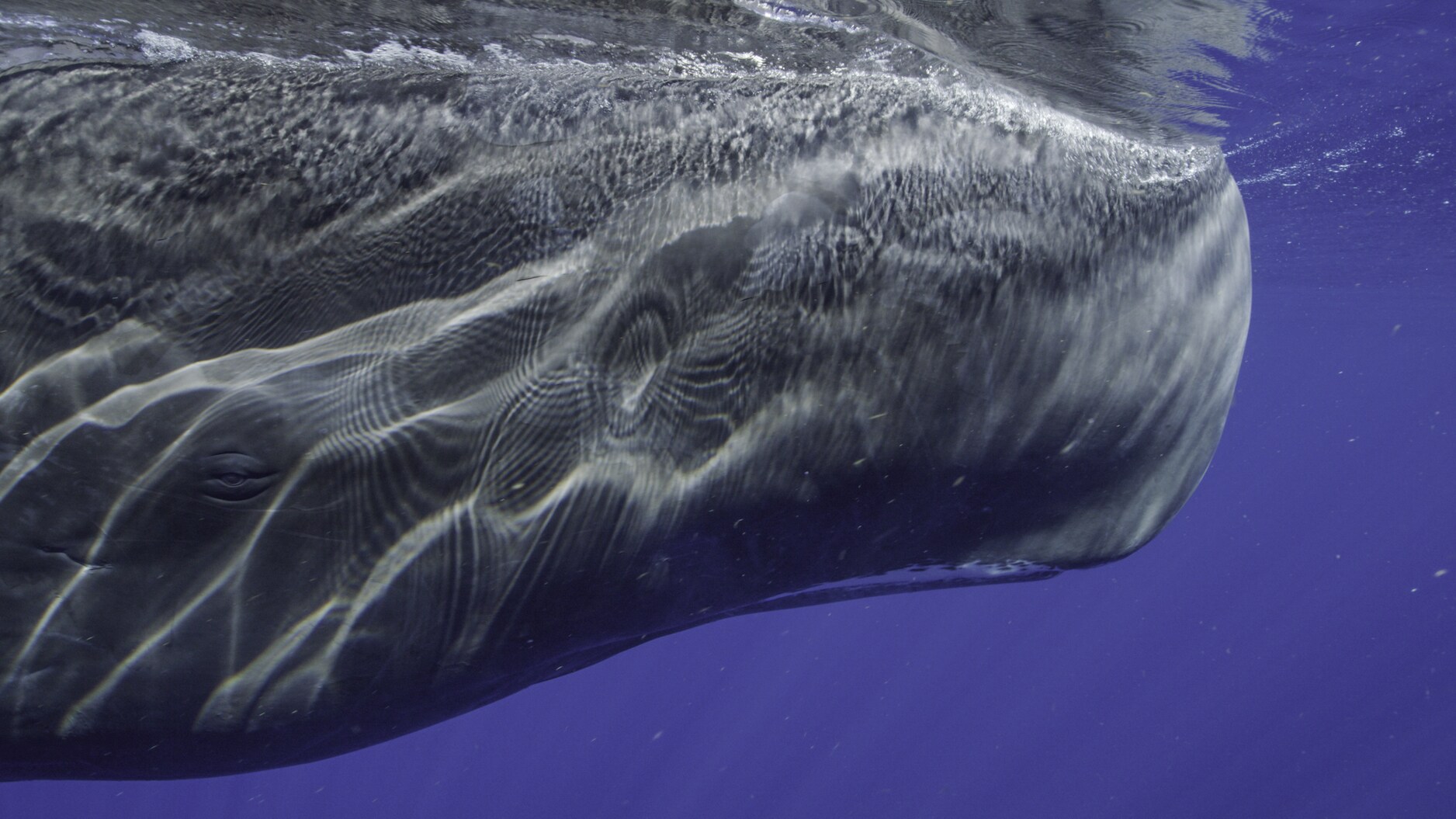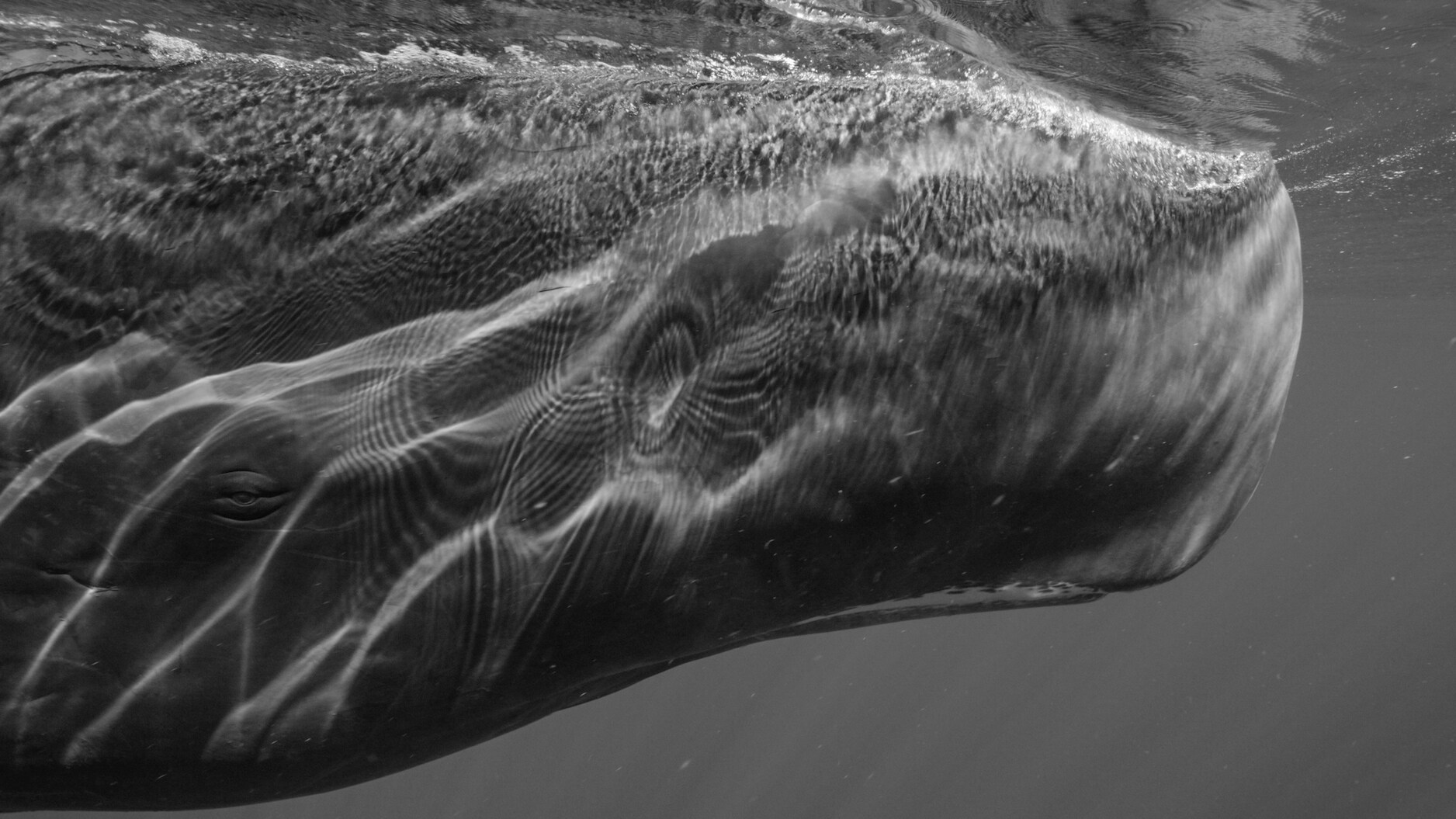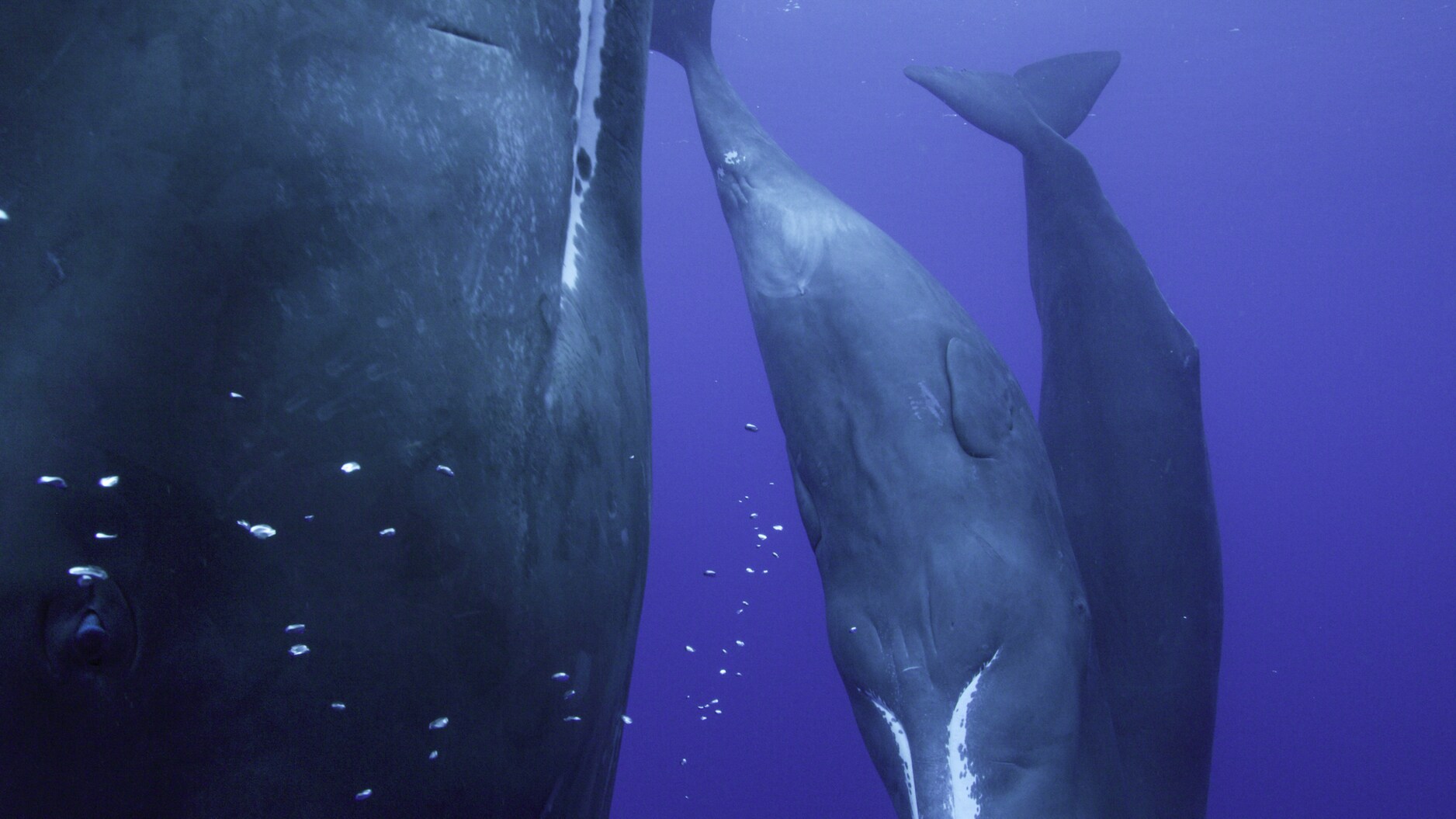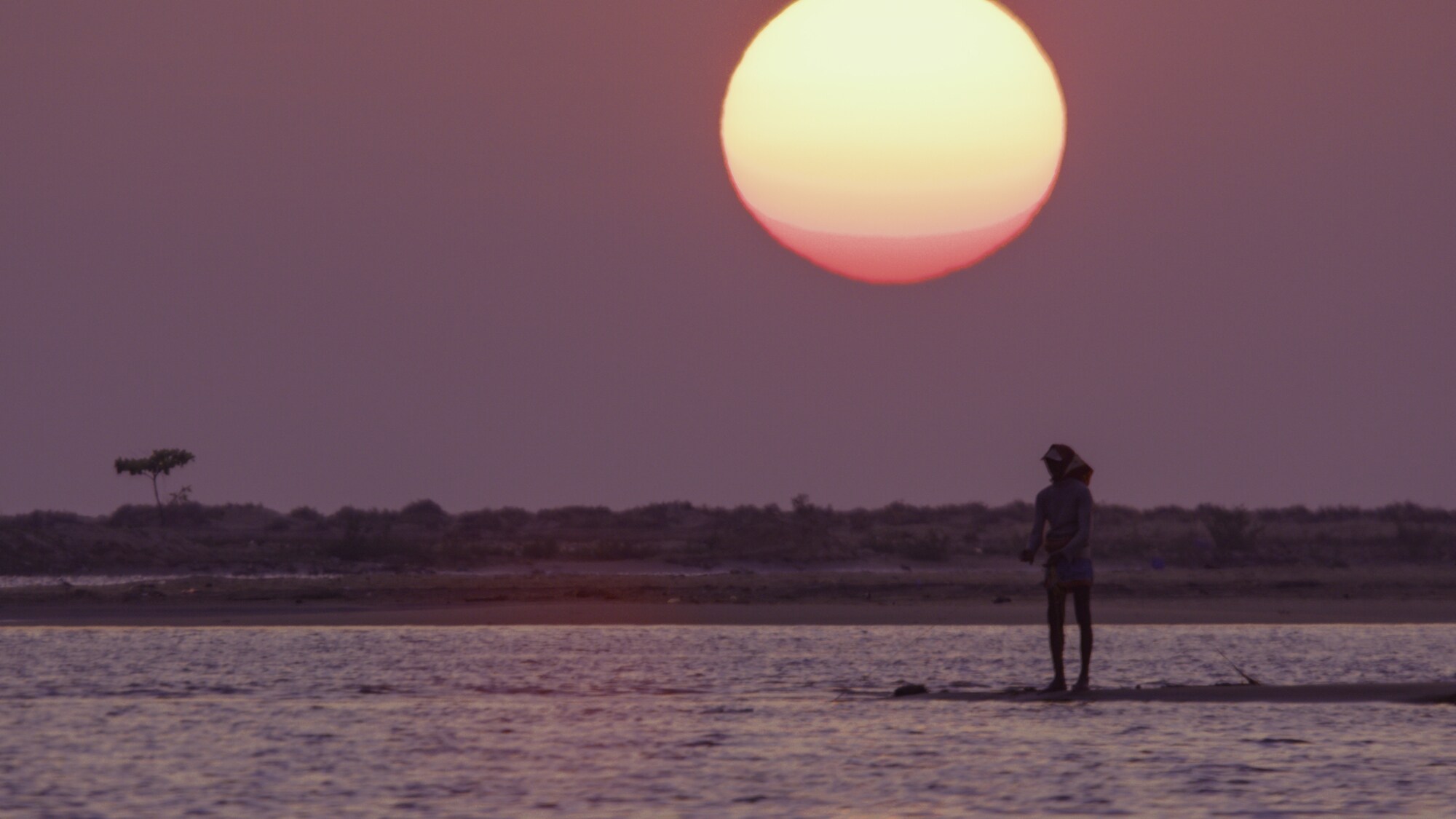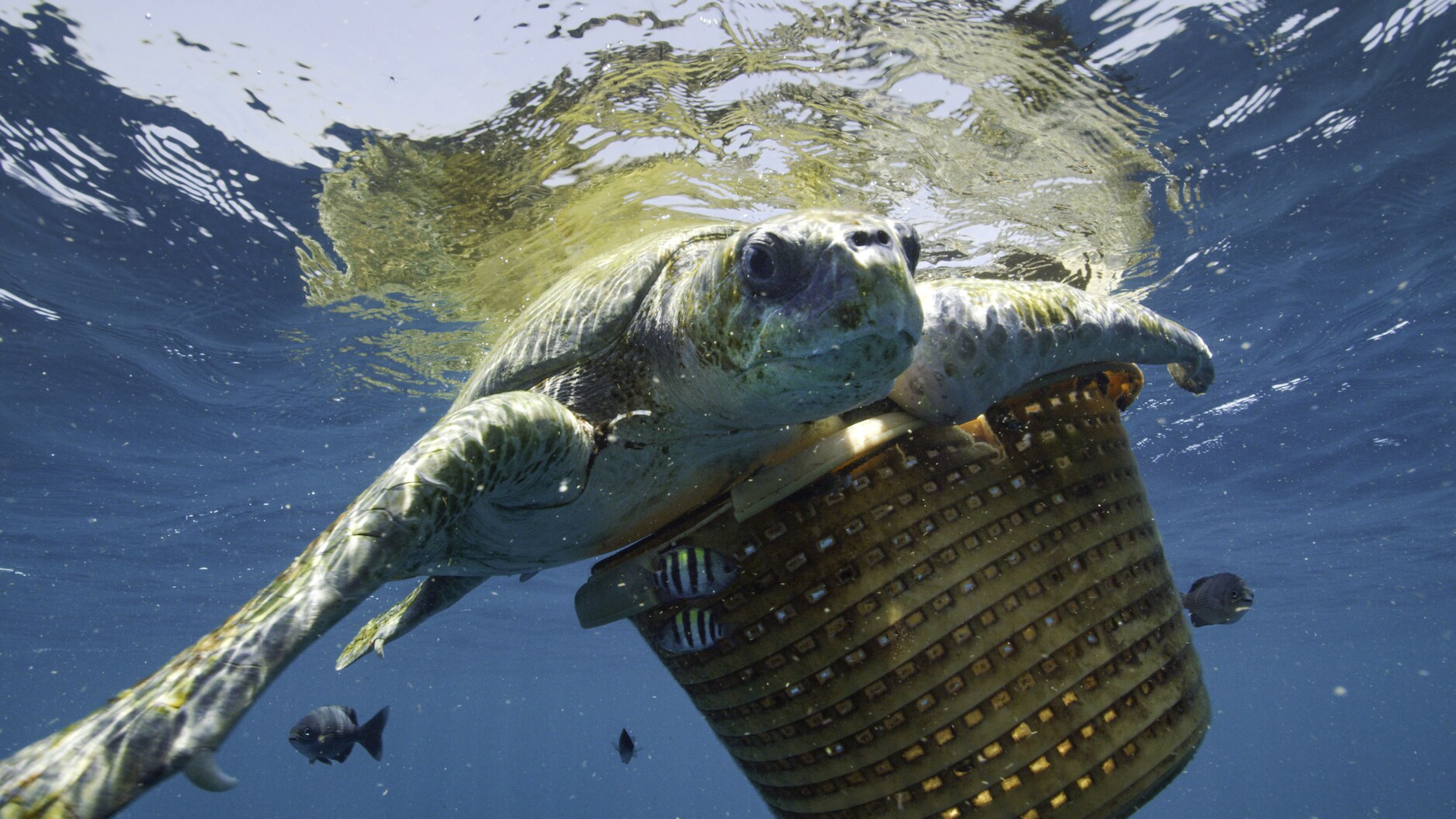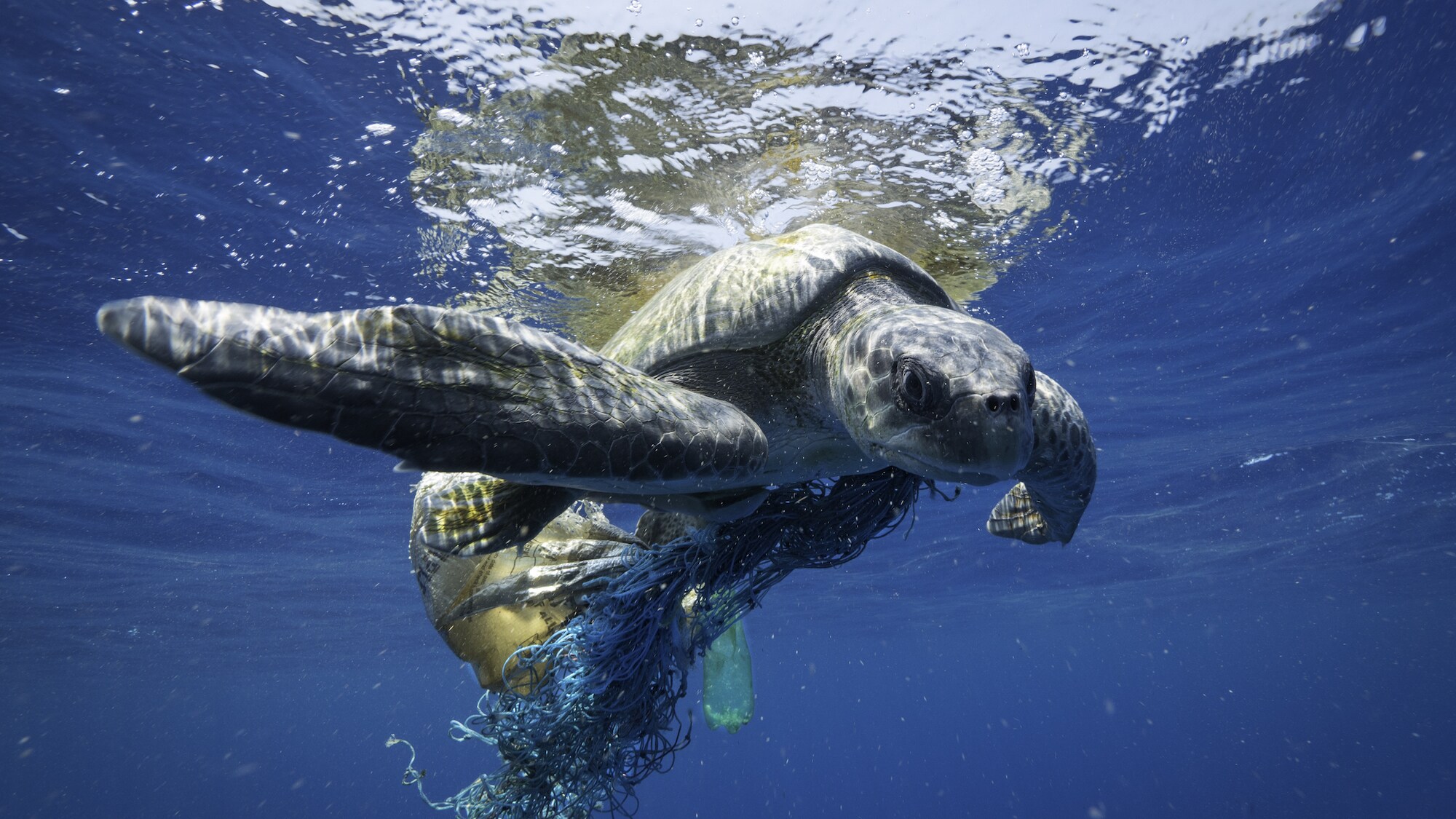Secrets of the Whales Episode 104: Ocean Giants
On an epic journey that spans the world’s oceans in Dominica, the Azores and Sri Lanka, witness the complex culture of the gentle giants. Relying solely on the next generation’s ability to learn their intricate ways, family culture and secrets, the sperm whales’ future rests upon its youngest members.
To download high-res images, click on the image and then use the Download button in the overlay that appears.
The National Geographic team tracked sperm whales off of the remote islands of the Azores, in the center of the Atlantic Ocean. (National Geographic for Disney+/Hayes Baxley)
ofThe National Geographic team tracked sperm whales off of the remote islands of the Azores, in the center of the Atlantic Ocean. (National Geographic for Disney+/Hayes Baxley)
ofSperm whales prefer to hunt far beneath the surface. They routinely stay an hour below and can explore as deep as 10,000 feet - all on one breath. (National Geographic for Disney+/Hayes Baxley)
ofSperm whales prefer to hunt far beneath the surface. They routinely stay an hour below and can explore as deep as 10,000 feet - all on one breath. (National Geographic for Disney+/Hayes Baxley)
ofSperm whales prefer to hunt far beneath the surface. They routinely stay an hour below and can explore as deep as 10,000 feet. (National Geographic for Disney+/Hayes Baxley)
ofSperm whales prefer to hunt far beneath the surface. They routinely stay an hour below and can explore as deep as 10,000 feet. (National Geographic for Disney+/Hayes Baxley)
ofMany sperm whales are wandering nomads. They travel freely across vast stretches of ocean and stop to interact with local whales. (National Geographic for Disney+/Hayes Baxley)
ofMany sperm whales are wandering nomads. They travel freely across vast stretches of ocean and stop to interact with local whales. (National Geographic for Disney+/Hayes Baxley)
ofMarine biologist Asha DeVos listens to sperm whale conversations with a hydrophone. She is listening for dialects that separate whale populations. (National Geographic for Disney+/Andrew Mitchell)
ofMarine biologist Asha DeVos listens to sperm whale conversations with a hydrophone. She is listening for dialects that separate whale populations. (National Geographic for Disney+/Andrew Mitchell)
ofMarine biologist Asha DeVos studies a sample of sperm whale dung, which will give her clues into what the whales are eating. (National Geographic for Disney+/Andrew Mitchell)
ofMarine biologist Asha DeVos studies a sample of sperm whale dung, which will give her clues into what the whales are eating. (National Geographic for Disney+/Andrew Mitchell)
ofThe National Geographic team tracked sperm whales off of the remote islands of the Azores, in the center of the Atlantic Ocean. (National Geographic for Disney+)
ofThe National Geographic team tracked sperm whales off of the remote islands of the Azores, in the center of the Atlantic Ocean. (National Geographic for Disney+)
ofThe National Geographic team tracked sperm whales off of the remote islands of the Azores, in the center of the Atlantic Ocean. (National Geographic for Disney+/Hayes Baxley)
ofThe National Geographic team tracked sperm whales off of the remote islands of the Azores, in the center of the Atlantic Ocean. (National Geographic for Disney+/Hayes Baxley)
ofNational Geographic photographer Brian Skerry documents a special orca society off the north island of New Zealand. (National Geographic for Disney+/Kina Scollay)
ofNational Geographic photographer Brian Skerry documents a special orca society off the north island of New Zealand. (National Geographic for Disney+/Kina Scollay)
ofNational Geographic photographer Brian Skerry spent three years documenting the cultural lives of whales. (National Geographic for Disney+/Luis Lamar)
ofNational Geographic photographer Brian Skerry spent three years documenting the cultural lives of whales. (National Geographic for Disney+/Luis Lamar)
ofNational Geographic photographer Brian Skerry spent three years documenting the cultural lives of whales. (National Geographic for Disney+/Luis Lamar)
ofNational Geographic photographer Brian Skerry spent three years documenting the cultural lives of whales. (National Geographic for Disney+/Luis Lamar)
ofNational Geographic photographer Brian Skerry spent three years documenting the cultural lives of whales. (National Geographic for Disney+/Andrew Mitchell)
ofNational Geographic photographer Brian Skerry spent three years documenting the cultural lives of whales. (National Geographic for Disney+/Andrew Mitchell)
ofThe National Geographic team tracked sperm whales off of the remote islands of the Azores, in the center of the Atlantic Ocean. (National Geographic for Disney+/Hayes Baxley)
ofThe National Geographic team tracked sperm whales off of the remote islands of the Azores, in the center of the Atlantic Ocean. (National Geographic for Disney+/Hayes Baxley)
ofMarine biologists Shane Gero and Asha DeVos eavesdrops on sperm whale conversations with a hydrophone. They are listening for dialects that separate whale populations. (National Geographic for Disney+/Luis Lamar)
ofMarine biologists Shane Gero and Asha DeVos eavesdrops on sperm whale conversations with a hydrophone. They are listening for dialects that separate whale populations. (National Geographic for Disney+/Luis Lamar)
ofMarine biologist Shane Gero eavesdrops on sperm whale conversations with a hydrophone. He is listening for dialects that separate whale populations. (National Geographic for Disney+/Luis Lamar)
ofMarine biologist Shane Gero eavesdrops on sperm whale conversations with a hydrophone. He is listening for dialects that separate whale populations. (National Geographic for Disney+/Luis Lamar)
ofMarine biologists Shane Gero and Asha DeVos eavesdrops on sperm whale conversations with a hydrophone. They are listening for dialects that separate whale populations. (National Geographic for Disney+/Luis Lamar)
ofMarine biologists Shane Gero and Asha DeVos eavesdrops on sperm whale conversations with a hydrophone. They are listening for dialects that separate whale populations. (National Geographic for Disney+/Luis Lamar)
ofWhales are more like us than we ever thought possible. New research shows that they are deeply intelligent beings with their own distinct cultures around the globe. (National Geographic for Disney+/Luis Lamar)
ofWhales are more like us than we ever thought possible. New research shows that they are deeply intelligent beings with their own distinct cultures around the globe. (National Geographic for Disney+/Luis Lamar)
ofSperm whales prefer to hunt far beneath the surface. They routinely stay an hour below and can explore as deep as 10,000 feet. (National Geographic for Disney+/Luis Lamar)
ofSperm whales prefer to hunt far beneath the surface. They routinely stay an hour below and can explore as deep as 10,000 feet. (National Geographic for Disney+/Luis Lamar)
ofWhales are more like us than we ever thought possible. New research shows that they are deeply intelligent beings with their own distinct cultures around the globe. (National Geographic for Disney+/Luis Lamar)
ofWhales are more like us than we ever thought possible. New research shows that they are deeply intelligent beings with their own distinct cultures around the globe. (National Geographic for Disney+/Luis Lamar)
ofMany sperm whales are wandering nomads. They travel freely across vast stretches of ocean and stop to interact with local whales. (National Geographic for Disney+/Luis Lamar)
ofMany sperm whales are wandering nomads. They travel freely across vast stretches of ocean and stop to interact with local whales. (National Geographic for Disney+/Luis Lamar)
ofUp to 26 long teeth line the sperm whale's lower jaw. Each one can weigh as much as 2lbs. (National Geographic for Disney+/Luis Lamar)
ofUp to 26 long teeth line the sperm whale's lower jaw. Each one can weigh as much as 2lbs. (National Geographic for Disney+/Luis Lamar)
ofWhales are more like us than we ever thought possible. New research shows that they are deeply intelligent beings with their own distinct cultures around the globe. (National Geographic for Disney+/Luis Lamar)
ofWhales are more like us than we ever thought possible. New research shows that they are deeply intelligent beings with their own distinct cultures around the globe. (National Geographic for Disney+/Luis Lamar)
ofSperm whales have the largest brains ever recorded - six times the size of our own. (National Geographic for Disney+/Luis Lamar)
ofSperm whales have the largest brains ever recorded - six times the size of our own. (National Geographic for Disney+/Luis Lamar)
ofSperm whales have the largest brains ever recorded - six times the size of our own. (National Geographic for Disney+/Luis Lamar)
ofSperm whales have the largest brains ever recorded - six times the size of our own. (National Geographic for Disney+/Luis Lamar)
ofSperm whales rest vertically, pausing every 10-15 minutes to breathe at the surface. They may rely on sleep less than any other mammal on the planet. (National Geographic for Disney+/Luis Lamar)
ofSperm whales rest vertically, pausing every 10-15 minutes to breathe at the surface. They may rely on sleep less than any other mammal on the planet. (National Geographic for Disney+/Luis Lamar)
ofThe National Geographic team traveled to Sri Lanka to test the theory that sperm whale populations have different dialects. (National Geographic for Disney+/Andrew Mitchell)
ofThe National Geographic team traveled to Sri Lanka to test the theory that sperm whale populations have different dialects. (National Geographic for Disney+/Andrew Mitchell)
ofFishing gear is the most common form of plastic pollution in the ocean, and it is often lethal to marine wildlife, including whales. The National Geographic team saved this sea turtle while on assignment in the Indian Ocean. (National Geographic for Disney+/Hayes Baxley)
ofFishing gear is the most common form of plastic pollution in the ocean, and it is often lethal to marine wildlife, including whales. The National Geographic team saved this sea turtle while on assignment in the Indian Ocean. (National Geographic for Disney+/Hayes Baxley)
ofEntanglement in marine debris, like this laundry bin, is often lethal to marine wildlife, including whales. The National Geographic team saved this sea turtle while on assignment in the Indian Ocean. (National Geographic for Disney+/Luis Lamar)
ofEntanglement in marine debris, like this laundry bin, is often lethal to marine wildlife, including whales. The National Geographic team saved this sea turtle while on assignment in the Indian Ocean. (National Geographic for Disney+/Luis Lamar)
ofFishing gear is the most common form of plastic pollution in the ocean, and it is often lethal to marine wildlife, including whales. The National Geographic team saved this sea turtle while on assignment in the Indian Ocean. (National Geographic for Disney+/Hayes Baxley)
ofFishing gear is the most common form of plastic pollution in the ocean, and it is often lethal to marine wildlife, including whales. The National Geographic team saved this sea turtle while on assignment in the Indian Ocean. (National Geographic for Disney+/Hayes Baxley)
ofAll images ©Disney. Editorial use only.
 Press.disney.co.uk
Press.disney.co.uk
